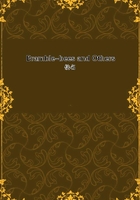
第13章 THE OSMIAE.(1)
February has its sunny days, heralding spring, to which rude winter will reluctantly yield place. In snug corners, among the rocks, the great spurge of our district, the characias of the Greeks, the jusclo of the Provencals, begins to lift its drooping inflorescence and discreetly opens a few sombre flowers. Here the first Midges of the year will come to slake their thirst. By the time that the tip of the stalks reaches the perpendicular, the worst of the cold weather will be over.
Another eager one, the almond-tree, risking the loss of its fruit, hastens to echo these preludes to the festival of the sun, preludes which are too often treacherous. A few days of soft skies and it becomes a glorious dome of white flowers, each twinkling with a roseate eye. The country, which still lacks green, seems dotted everywhere with white-satin pavilions. 'Twould be a callous heart indeed that could resist the magic of this awakening.
The insect nation is represented at these rites by a few of its more zealous members. There is first of all the Honey-bee, the sworn enemy of strikes, who profits by the least lull of winter to find out if some rosemary is not beginning to open somewhere near the hive. The droning of the busy swarm fills the flowery vault, while a snow of petals falls softly to the foot of the tree.
Together with the population of harvesters there mingles another, less numerous, of mere drinkers, whose nesting-time has not yet begun. This is the colony of the Osmiae, with their copper-coloured skin and bright-red fleece. Two species have come hurrying up to take part in the joys of the almond-tree: first, the Horned Osmia, clad in black velvet on the head and breast and in red velvet on the abdomen;and, a little later, the Three-horned Osmia, whose livery must be red and red only. These are the first delegates despatched by the pollen-gleaners to ascertain the state of the season and attend the festival of the early blooms. 'Tis but a moment since they burst their cocoon, the winter abode: they have left their retreats in the crevices of the old walls; should the north wind blow and set the almond-tree shivering, they will hasten to return to them. Hail to you, O my dear Osmiae, who yearly, from the far end of the harmas (The piece of waste ground in which the author studied his insects in their natural state. Cf. "The Life of the Fly" by J. Henri Fabre, translated by Alexander Teixeira de Mattos: chapter 1.--Translator's Note.), opposite snow-capped Ventoux (A mountain in the Provencal Alps, near Carpentras and Serignan, 6,271 feet.--Translator's Note.), bring me the first tidings of the awakening of the insect world! I am one of your friends; let us talk about you a little.
Most of the Osmiae of my region have none of the industry of their kinswomen of the brambles, that is to say, they do not themselves prepare the dwelling destined for the laying. They want ready-made lodgings, such as the old cells and old galleries of Anthophorae and Chalicodomae. If these favourite haunts are lacking, then a hiding-place in the wall, a round hole in some bit of wood, the tube of a reed, the spiral of a dead Snail under a heap of stones are adopted, according to the tastes of the several species. The retreat selected is divided into chambers by partition-walls, after which the entrance to the dwelling receives a massive seal. That is the sum-total of the building done.
For this plasterer's rather than mason's work, the Horned and the Three-horned Osmia employ soft earth. This material is different from the Mason-bee's cement, which will withstand wind and weather for many years on an exposed pebble; it is a sort of dried mud, which turns to pap on the addition of a drop of water. The Mason-bee gathers her cementing-dust in the most frequented and driest portions of the road; she wets it with a saliva which, in drying, gives it the consistency of stone. The two Osmiae who are the almond-tree's early visitors are no chemists: they know nothing of the making and mixing of hydraulic mortar; they limit themselves to gathering natural soaked earth, mud in short, which they allow to dry without any special preparation on their part; and so they need deep and well-sheltered retreats, into which the rain cannot penetrate, or the work would fall to pieces.
While exploiting, in friendly rivalry with the Three-horned Osmia, the galleries which the Mason-bee of the Sheds good-naturedly surrenders to both, Latreille's Osmia uses different materials for her partitions and her doors. She chews the leaves of some mucilaginous plant, some mallow perhaps, and then prepares a sort of green putty with which she builds her partitions and finally closes the entrance to the dwelling. When she settles in the spacious cells of the Masked Anthophora (Anthophora personata, ILLIG.), the entrance to the gallery, which is wide enough to admit one's finger, is closed with a voluminous plug of this vegetable paste. On the earthy banks, hardened by the sun, the home is then betrayed by the gaudy colour of the lid. It is as though the authorities had closed the door and affixed to it their great seals of green wax.
So far then as their building-materials are concerned, the Osmiae whom I have been able to observe are divided into two classes: one building compartments with mud, the other with a green-tinted vegetable putty. The first section includes the Horned Osmia and the Three-horned Osmia, both so remarkable for the horny tubercles on their faces.